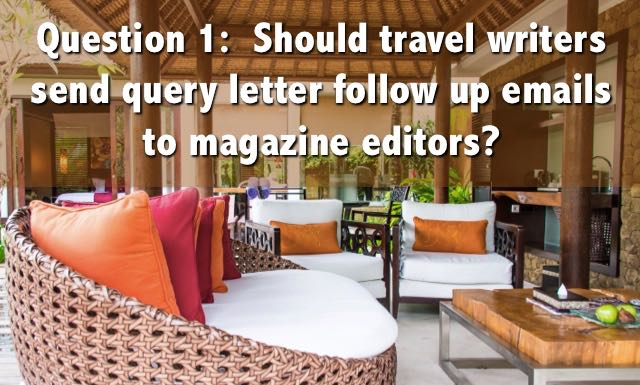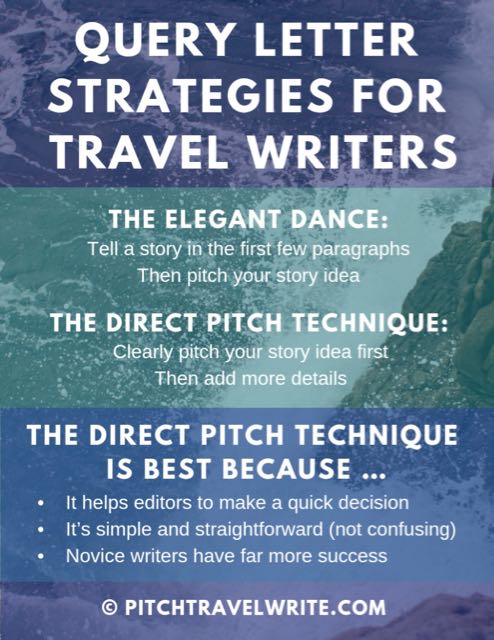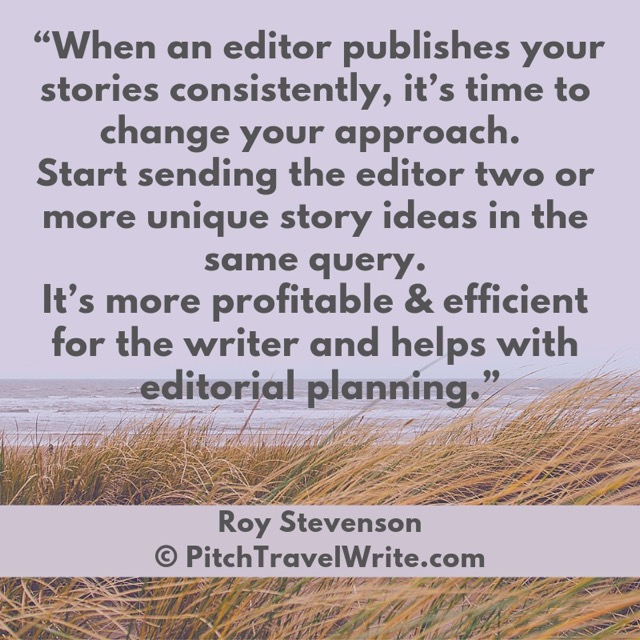- Home
- Query Letters
- Query Letter Tips for Follow-up and Tracking
Query Letter
Tips for Travel Writers:
Follow-Up
and Submissions Tracking
By Roy Stevenson
These query letter tips are related to followup and tracking - questions that come up regularly by email, social media or from travel writers at a conference.
Here are my tips and advice:
Query Letter Tips for Follow Up

The first question recently appeared on my Facebook page. It came from a novice travel writer named Mary. Her questions and my answer spurred some interesting discussion with another one of my freelance writing friends, as you’ll see in the dialog below:
Question:
“I'm getting ready to send follow-up letters for some queries I sent 4 weeks ago. Can you offer some advice? Should I include the original query? What would you suggest as an opener?
-Mary
My Answer:
“Hi Mary - I never have to do follow-up
letters or emails. I sell 90% of my stories on my first round of
queries, so I never bother sending follow-ups. I’ve always considered
follow-ups a waste of time.
If an editor has not responded to
your query within 4-6 weeks of receiving it, he or she is probably not
interested in the story. Sorry that I can't be of more help to you.”
But that wasn't the end of it. One of my freelance travel writer friends also responded:
“I follow up on all my pitches after two weeks and get most of my assignments after following up. I do include the original query and just a short note. Something like, "About two weeks ago I sent you the following query about _______. Are you still considering it?"”
I was amazed to read this. So, I questioned my writer friend for more details.
I asked her, “Do you think you get these assignments because the editors have just been sitting on your queries and forgotten about them? And, do you have any idea what % of your follow-ups are landing you assignments?”
She replied: “I can't just quantify pitches and assignments because I also send out a ton of queries. My experience has been when I put "following up" in the subject line, I'm much more likely to get an answer. So, I doubt that the editors are sitting on my pitches. I think it's more like they missed them the first time or they went into their spam folder.”
She adds, “I have a standard format for follow-ups. They take me less than two minutes, so mine aren't that time consuming and, to clarify, they are almost always to editors who are new to me.”
This fascinating interchange illustrates how two freelance travel writers can use different systems and both can get results. Here’s the difference:
I use the assembly line querying system. I send out a large number of simultaneous queries on the first round, and I inevitably find an editor interested in buying my story. Follow-ups are definitely not an integral part of my freelancing world because I've already made the sale.
I've always felt that an editor will either "go" for my pitch, or just delete it—either of which is okay with me.
Maybe there's something in my query letters that compels editors to respond quickly. Because interested editors respond to my queries within a few days, there is no need for me to bother with time-consuming follow-ups. Instead I spend my time writing new queries or writing the articles.
On the other hand, my friend sends out follow up emails to every editor who hasn't responded. She’s also been widely published, and she attributes a good deal of her success to query letter follow ups. Follow-ups are part of her “system”.
She says she includes the words “following up” in her subject line and she gets most of her assignments with new editors after following up.
Both systems obviously sell articles, so the takeaway message is both systems work. Based on your personal success rate, you can decide whether or not you need to incorporate query letter follow ups into your freelance travel writing process.
For this query letter tip, I recommend, if you’re not getting a high response rate (40% or better) to your original queries from editors, you should seriously consider sending brief follow-up emails 2-4 weeks after you send out your original pitch.
Query Letter Tips about Tracking Query Letter Submissions and Follow-Ups
"Hi Roy,
I am (finally!) at the stage where I am ready to ramp up a full-blown marketing effort, and I am setting myself a goal of submitting 50 queries a week to who knows how many publications. Of course I want to keep track of what’s going on in the various stages of acceptance and rejection, and I want to make sure I always respond/follow-up appropriately and in a timely fashion.
My question is, have you devised an effective submission/query tracking system?
There are all kinds of things I want to track including the origin of the contact, such as referral, website, Writers Guidelines, lists, etc. Then the name of the contact, their title, name of publication, dept. of publication, description of piece, length of piece, number of photos submitted, price to be paid, when to be paid, who and how to invoice, etc. . . ."
This is an excellent question. Read any freelance writing book by the ‘experts’ and they’ll give you the query letter tip to keep detailed records, called “Submissions Trackers”.
As I said previously, I don’t bother to track my queries. This is because I sell 90% of my stories on my first round so I don’t need to track follow-ups. This saves me a great deal of time.
However, in my first year of freelance writing I tried keeping a basic spreadsheet with a record of all my queries. But, I was sending out so many queries that I found myself spending large chunks of time transferring this information onto a spreadsheet.
This practice was so time consuming it became impractical, so I soon abandoned it. When I realized that my pitches were selling nine out of ten stories anyway, it just wasn’t necessary. If I wanted to see what queries I had sent out, I could look in my “Sent” mail.
I realize this answer doesn’t help a novice travel writer with a much lower acceptance rate for his queries.
My query letter tip is this: to boost your acceptance rate for your pitches make sure you’re doing the following six steps thoroughly. I call this my Marketing Mastery Links Formula ™. It consists of six core activities you need to do to be successful:
My Marketing Mastery Links Formula ™ to Sell More Stories:
1. Dream up and develop saleable travel story ideas and angles.
2. Research your topics thoroughly.
3. Create a distribution list to pitch to.
4. Create a solid query letter that resonates with editors.
5. Deliver a quality piece in a timely manner.
6. Develop strong relationships with editors and get repeat business.
Ignore or underperform any of these steps at your own risk. Skimp on any of these steps and your chances of getting your stories into print—and getting paid for them—plummet. Just saying!
If you still want to keep records on query letter submissions and follow up, here’s my query letter tip:
1. Keep your submissions tracker simple. Use a table something like this one:
Only include extra information that you believe is necessary. Use a Word table, Excel spreadsheet or whatever software app will support you with this job. Keep it simple. Don’t create unnecessary work for yourself.
2. Pay attention to how much time you spend tracking your queries and query letter follow ups.
Don’t waste your time on a laborious tracking system. Your time is better spent dreaming up more story ideas, researching them, and writing killer query letters.
That's all the query letter tips I have for these questions. Good luck with your travel writing - and just keep pitching!
There's no need to struggle with writing a query letter.
Here's a guide that tells you everything you need to know, along with 20 sample query letters that you can use as templates to help you write your own queries.
It's a steal at less than $20.

Roy Stevenson is a professional travel writer and the author of www.PitchTravelWrite.com. Over the past ten years, he’s had more than 1000 articles published in 200 magazines, trade and specialty journals, in-flights, on-boards, blogs and websites and has traveled on assignment around the U.S. and to dozens of international destinations.
IF YOU ENJOYED THIS POST, GET UPDATES. IT'S FREE.

















